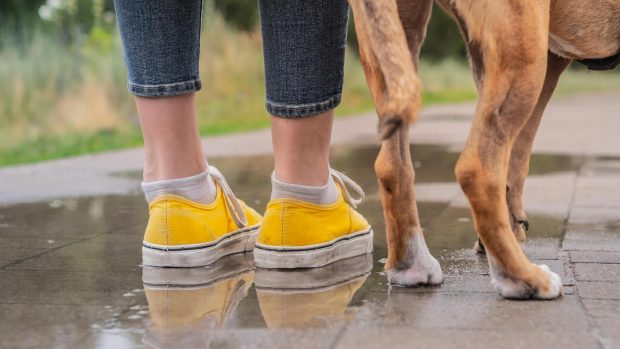There are 33 breeds with the name terrier registered with the UK Kennel Club, although a handful fit under other groups such as toy, utility and working dogs. It may come as a surprise that only two terriers feature in the top 15 most popular dog breeds in the UK, because they typically make a fabulous all-round pet and loyal friend.
There are common traits to the group, but also huge variety in their characteristics. While we may think of terriers typically as small, tough dogs, and this stature does dominate the group, there are a few toy terriers, a couple of medium-sized breeds and even a large – the Russian Black Terrier, a relatively new working breed developed by the Russian army as a specialised guard dog, with one of his duties to round up fugitives. And a couple are terriers by name, but not by nature, including the Boston Terrier. This fits in the Utility dog group, as it has non-sporting origins. Although it is said to be a cross between the bulldog and English White Terrier, it doesn’t behave like a typical terrier and is far more at home in its owner’s company, often in urban situations such as the eponymous Boston, than down a badger hole!
The word terrier stems from the Latin word “terra” which means earth. Terriers were essentially bred to chase game, such as fox, badger and otter, as well as vermin, to earth – that is, down into their holes below ground. This gave rise to a tough, tenacious and courageous little dog, small enough to fit down animals’ underground lairs, and brave enough to do battle with a bigger beast if it came to it.
As they have been specifically developed over centuries to hunt, kill vermin and protect their human family – whether the farm, yard or home – they typically have extraordinary tenacity (some may say stubbornness!), unstoppable energy, and are often very happy with the sound of their own voice should they perceive any sort of threat whatsoever. Add to this a propensity for digging – going to earth is their metier, after all – and you may be wondering why they are such a popular family pet. However, they are nearly always staunchly loyal, devoted to their families and hugely playful with awesome personalities.
Another bonus is the depth of variety within the group; there is a terrier for all tastes. Do you want a silky lap dog that will fit in your handbag or a city apartment? The Australian Silky Terrier has your name on it. Or a rough-and-tumble, hardy type that will not only dispatch rats on the yard but keep up with your horse out on hacks? The Irish Terrier’s the one for you. Perhaps you’re simply after an all-round, good guy with distinctive looks? The affectionate bull terrier would fit the bill.
Let’s take a look at a handful of different terrier breeds that encapsulate the variety within the group.
Examples of terrier breeds

Adorable looks, with a feisty spirit
Norfolk Terrier
Distinct since the 1960s from the very similar Norwich Terrier, which has pricked ears to the Norfolk’s drop ears. Both were bred to work the drains of their native East Anglia, getting rid of rats.
This small terrier is described as a “demon for its size”, measuring up at just 25cm at the withers. These appealing little dogs are proper terriers: they dig, catch mice and rats and have a loveable and genial temperament.
Although they’re typically good with children, and look adorably cute, this is no lap dog. They are alert and fearless, and with their finely honed instinct to pursue small things, tend to be highly active and tenacious!
Like most terriers, their naturally harsh, wiry coats need hand stripping to remove the old coat and regular grooming, with straggly hairs pulled out.

The Airedale is known as the “King of Terriers”
Airedale Terrier
The Airedale highlights the range of size and working capacity within the terrier group, as this is the largest of the terrier breeds and has held down all sorts of jobs, from controlling vermin on riverbanks to being a messenger in the World War trenches.
Developed in Yorkshire, the Airedale is known as the “king of terriers”, standing up to 61cm tall. They add to this superior look with a distinguished moustache and earnest dark eyes. In common with nearly all other terrier breeds, he has a fearless, alert and confident temperament, high energy levels and is always ready for a challenge.

Yorkshire Terrier
This toy breed is far less likely to be seen digging its way down a fox’s earth than on a silk cushion in the show ring. Although the breed has working terrier in its ancestry – such as the now-extinct black and tan terrier, as well as Maltese and Skye Terrier bloodlines – the silky-coated, long-haired Yorkie has emerged into more of a lapdog.
They have terrier traits, such as their playfulness, alertness and friendly disposition, and seem to believe they are really a big dog in a (very) small package, weighing a maximum of just 3.5kg. They are trainable, and enjoy mini agility and any opportunity to show off. However, while most terrier breeds are tough, hardy and wiry workmen, the Yorkie looks like the glamorous show dog they really are. They need dog coats to keep warm in winter, protection from larger, boisterous dogs in the park and a lap to sit on.

Scruffy, sturdy, workmanlike – but undeniably cute
Glen of Imaal Terrier
A fearless and tenacious terrier, bred to hunt badger in Co Wicklow over the Irish Sea. Sadly, this game and spirited worker is listed as one of the 35 vulnerable dog breeds, with just 58 puppy registrations in the UK in 2023.
As well as being a no-fuss, no-frills, sturdy little dog built for hard work, Glens tend to be less excitable and slightly more docile than the average terrier, which means they knuckle down as a great family pet as well. And with their soft colours (blue, brindle and wheaten), their rugged, scruffy looks and bold, spirited personality, they make a wonderfully cute addition to the home.

The smiling Staffie
Staffordshire Bull Terrier
Essentially part bulldog, part terrier, the popular “Staffie” is eighth on the list of most popular dog breeds in Britain and the top terrier. Solid as a rock, muscular, courageous and tenacious, the Staffie may look like a prize gladiator, but in good hands is known for being a mild-mannered playmate who gets on brilliantly with kids.
Less like a typical terrier, and more resembling a bulldog than most in the group, the smiling Staffie shares many of the terrier character traits, such as being bold, fearless and staunchly loyal to his people.
List of terrier breeds
- Airedale Terrier
- Australian Silky Terrier
- Australian Terrier
- Bedlington Terrier
- Border Terrier
- Boston Terrier
- bull terrier
- Bull Terrier (miniature)
- Cairn Terrier
- Cesky Terrier
- Dandie Dinmont Terrier
- English Toy Terrier
- fox terrier (smooth and wire)
- Glen of Imaal Terrier
- Irish Terrier
- Jack Russell Terrier
- Kerry Blue Terrier
- Lakeland Terrier
- Manchester Terrier
- Norfolk Terrier
- Norwich Terrier
- Parson Russell Terrier
- Russian Black Terrier
- Scottish Terrier
- Sealyham Terrier
- Skye Terrier
- soft-coated wheaten terrier
- Staffordshire Bull Terrier
- Tibetan Terrier
- Welsh Terrier
- West Highland White Terrier
- Yorkshire Terrier

How to stop a dog digging in the garden: advice from an expert

Puppy incoming! How to dog-proof your home ready for the new arrival

All about the Jack Russell Terrier, a breed loved by our King and Queen

No more yapping: how to stop a dog nuisance barking

Upset neighbours and sleepless nights? The best dog collars to stop excessive barking

Subscribe to Horse & Hound magazine today – and enjoy unlimited website access all year round
Horse & Hound magazine, out every Thursday, is packed with all the latest news and reports, as well as interviews, specials, nostalgia, vet and training advice. Find how you can enjoy the magazine delivered to your door every week, plus options to upgrade your subscription to access our online service that brings you breaking news and reports as well as other benefits.




